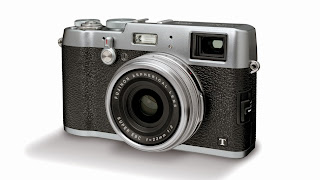Fujifilm refined the formula and performance with the X100S almost 2 years ago, and now the company's back with the X100T.
The Fujifilm X100T shares the same 16.3MP X-Trans CMOS II image sensor, the same EXR Processor II image processor, and the same bright 35mm-equivalent f/2.0 prime lens that together makes this a great little candid street shooter.
Key Features:
|
Some of the biggest new features can be found in the viewfinder. This focus aid is available when using the optical viewfinder on the X100T; the focus patch shows up in the bottom corner of the viewfinder, so you can effectively focus manually when using the optical finder.
The optics of the viewfinder have been adjusted so that it provides coverage of 92% of the final image, when used in optical mode. This figure refers to the framing offered by the 'brightlines' shown in the finder - they're less than 100% because the actual field-of-view changes, based on focus distance: the 92% coverage is a compromise between the field-of-view and closest focus and at infinity.
The EVF LCD is now a 2.3-million dot panel that offers 100% coverage of the scene. The screen on the back of the camera has gotten a refresh, too, jumping to 3-inches from 2.8-inches, and (more importantly) jumping more than 50% in resolution up to 1.04-million dots.
There are a few external changes, as well. The top and bottom plates are now magnesium, and ridges have been added to the shutter speed dial, aperture ring, and exposure compensation dial. The exposure compensation dial now extends to +/-3 EV, an improvement from the +/-2 EV supported by the X100S, and the camera's command lever has been replaced by a 4-way controller.
The Fujifilm X100T also adds a fully electronic shutter mode. The brand new electronic shutter delivers ultra-high-speed exposures up to 1/32000sec. Shallow depth-of-field effects can now be shot with the aperture wide open even in snow or on the beach under clear skies. As there are no mechanically operated parts, there is no shutter sound so natural expressions of animals and sleeping babies can be captured more easily than ever before.
The camera's aperture ring has been modified, so that it can now be controlled in 1/3 f-stops, rather than the whole stops that the existing models offered. The exposure compensation dial has also been amended so that it now extends to +/- 3EV - something existing users had been calling out for. The other big change, in terms of exposure control is that the X100T retains the ability to apply exposure compensation when using Auto ISO in manual exposure mode, meaning that you can choose shutter speed, aperture and image brightness and let the camera do the work.
Fujifilm has also gifted the X100T with in-camera Wi-Fi connectivity -- Built-in Wi-Fi means users no longer have to rely on wireless SD cards for sharing images, and remote shooting is possible with the Fujifilm Camera Remote app for iOS and Android devices.
The Fujifilm X100T can also pair up with an Instax SHARE Smartphone Printer for a quick and easy printout.
The Fujifilm X100T also features the Classic Chrome film simulation mode that first appeared last month on the X30 compact camera.
The camera, which uses die-cast magnesium alloy for the top and bottom of the body, measures 126.5 x 74.4 x 52.4 mm (5 x 2.9 x 2.1 in) and weighs 440 g (15.5 oz).







The Fujifilm X100T shares the same 16.3MP X-Trans CMOS II image sensor, the same EXR Processor II image processor, and the same bright ... ifujifilmx100t.blogspot.com
ReplyDeleteThe Fujifilm X100T shares the same 16.3MP X-Trans CMOS II image sensor, the same EXR Processor II image processor, and the same bright ... ifujifilmxt.blogspot.de
ReplyDelete